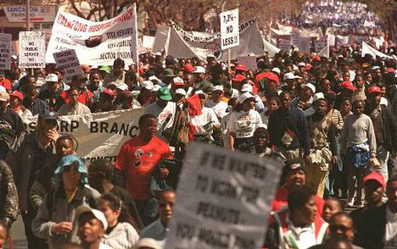 |
Peoples' movements and protests |
 |
|
MobilizationsWomen’s movementsFrench Revolution19th century republican movementThe black movement in the United StatesThe black movement in South AfricaNative American movementsBack to Civil rights movementsBack to main page
|
The apartheid resistance in South Africa
he South African civil rights movement against the dictatorship of the settler minority was a fairly sporadic story until 1945 when i.a. the Indian independence movement inspired a younger generation of blacks. It was expressed i.a. in a miners’ strike that grew into a general strike in 1946. Instead of the expected compromises, however, this led to the settlers becoming even more determined to suppress the majority with petty control legislation, and the civil rights movement in the 1950s aimed at organized violations of these laws. The campaign drew in hundreds of thousands but was broken with mass arrests in 1961. After that, little happened for ten years. In the early 1970s, however, schoolchildren began to discuss ”spiritual” resistance in terms of ”self-respect”, Black Consciousness, or BC. Young people marked by that movement organized in June 1976 a protest march in the slum town of Soweto against teaching in a language incomprehensible to all, and that movement spread rapidly throughout the country. To reach the older generation, the young people expanded their actions to boycotts and rent strikes, but this led to new mass arrests and a new halt in the movement. The next step began in 1983 when the government tried to co-opt Indians and so-called cape colored as junior partners in apartheid with some co-determination in a new three-chamber parliament. Against this, a broad campaign organization, the United Democratic Front, UDF, was organized, consisting mainly of youth organizations, for the demand the same right for all. The business grew on a legal basis and after a year had gained such a breadth that a new wave of rent strikes could not be crushed. Mainly because the UDF had gradually begun to have a democratic organization that, unlike the tradition of the 1950s, stood and fell with a small number of leaders. In 1984 and 1985, the government was driven out of townships and white merchants and others were forced to adapt. The goal was to ”make South Africa ungovernable”. A state of emergency in 1985 meant little to suppress the movement. At the same time, the hitherto strictly pennies-oriented trade unions became increasingly political. When the state of emergency was tightened in 1986 and tens of thousands of UDF activists were imprisoned, it was the unions that took over the resistance, together with the churches, and carried out political strikes in parallel with the traditional rent strikes and boycotts. In addition, the movement of sympathty actions internationally grew to the most encompassing international movement ever. In 1990, repression had become too expensive for the government – the military budget became too high for voters and the unruliness and international loathing too unprofitable for business. The government was forced to abandon its policies and accept the general citizenship the black organizations demanded all the time. In 1994, a black leadership was elected for the country, which, however, was promptly forced into a neoliberal policy by IMF pressure. On the other hand, opposition to this policy now has one of its global cornerstones in the South African trade union movement and in the township organizing from the time of the apartheid resistance.
Reading
|

